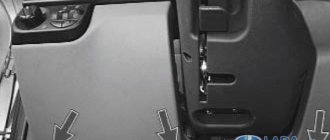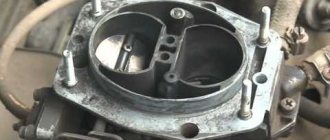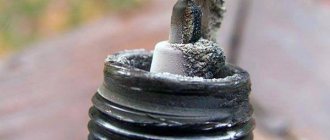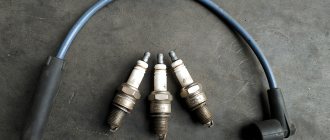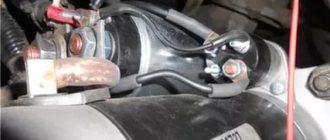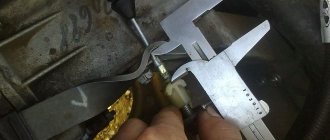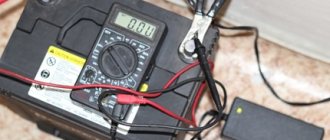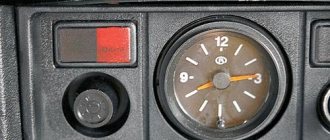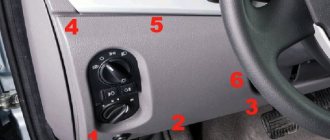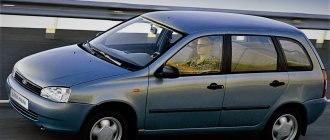Good day! Tell me what to do, my Kalina has trouble starting when it’s cold. Sometimes you have to start it several times, the revs are low and it doesn’t hold. You have to apply more gas, after which they level out. What could be the problem? I'll go for diagnostics as a last resort if I can't figure it out myself.
I don’t even know; without diagnostics it will be difficult to determine the cause. You need to measure the pressure in the fuel rail, check the spark plugs, clean the throttle, check the sensors. Too much work
Buy the simplest on-board computer and install it on your Kalina Delov...
I will prioritize:
- replace the spark plugs;
- replace high-voltage wires;
- check the temperature sensor;
- check and, if necessary, replace the TPS;
Somehow like this
Your Kalina doesn't start well when it's cold, I'm familiar with this problem. He himself spent a lot of time and effort to resolve the unpleasant situation. Looking ahead, I’ll say that you can give strength to the engine of your car yourself, at least I personally managed to do it. Now I’ll tell you in order what I checked, what I replaced so that Kalina would start normally.
The main culprits of the engine not starting
So what to do if Kalina does not start and does not turn the starter? There are many reasons. Some problems can be fixed on your own, while others can only be fixed at specialized service stations.
Immobilizer
Not all Kalinas have the immobilizer activated from the factory, but you can disable it if you are afraid of its glitches. If you do not have it activated, then this problem should not affect you.
This may be the first reason why the car won't start. You can fix it yourself. If the immobilizer starts blinking, then in order to understand the specific cause of the malfunction you need to sit down and read the manual: what each light means, as well as the frequency of flashes and buzzers. In the cold season, the car can only be started after 5-6 times.
The photo shows a red key for clarity. The red block in the photo is a memory element for the immobilizer; it can become out of sync or break.
This problem can be solved by reflashing the key.
Starter
In the case when the previous system is in good condition, another reason why the car does not start may be the starter. Only a deaf person would fail to notice that this unit is not working.
Starter under the hood of Kalina. Check the power to the starter, circled in red.
Control unit (ECU)
This is also a common reason why the engine will not start. Usually, if you don't touch it, there are no problems with it. Often the unit can fail when it is flooded with water. This is a design flaw, or rather a flaw in the location of the ECU (a known problem with Kalin).
The ECU in Kalina is located at the bottom; due to leaks during rain, it can easily be flooded with water
In this case, the block will have to be replaced completely. To protect yourself, you should insulate it well or move it to another place under the hood. You cannot wrap the block in polyethylene, as it will fail due to condensation.
Candles
Condition of the candles in the photo
They are usually flooded in the cold season. This can also happen when the battery is weak. In this case, you need to dry the candles. They can be cleaned from carbon deposits with a toothbrush. The gap should also be kept within 0.8-1 millimeter. You can also use a hairdryer. If you have spare spark plugs, you can replace them.
Fuel
It can also be the reason why the engine will not start. To protect yourself from low-quality fuel, you need to refuel your car only at time-tested gas stations.
Fuel pump and relay
The fuel pump is universal and fits all models of the VAZ family.
If the engine does not start when the starter cranks the engine, then the cause may be the fuel pump and it needs to be replaced. You need to open the hood and find the cap to the left of the injectors. When you press it, gasoline should spray out. When gasoline enters the engine, it is not the fuel pump. The relay may fail.
About DTOZH
In general, power unit temperature sensors are the most important regulators of an injection engine. There are two of them on it. One is located directly in the cylinder head, it displays the temperature value on the instrument panel.
The second one is located in the thermostat, and provides data on the temperature of the control unit of the power unit. Based on the results obtained, the control unit regulates the fuel supply - it supplies more fuel to a cold internal combustion engine, and less to a hot one. In addition, it is the control unit that regulates the OZ, influences the ignition of the fuel assembly, and activates the coolant fan if the liquid temperature rises above 100 °C.
Obviously, with faulty DTOZh there will be difficulties in the operation of the motor. However, this applies more to the DTOZH, which provides information directly to the block. For example, if the DTOZH is faulty, it will give false values about a cold engine, although it is already boiling. The supply of fuel to the cylinders will increase, because this is provided by the system. Let's say you drove for a long time, then stopped and went into a store. Now starting the power unit will cause obvious displeasure, since it will take a very long time to start due to data failures and oversaturation.
At the same time, the SOP, which is responsible for the ignition of a fuel assembly that is clearly over-enriched, changes greatly. As a result, the fuel will evaporate intensively, and the concentration of gasoline in the fuel assembly will be so high that the mixture will hardly ignite due to the small amount of oxygen.
It was said above that when you press the accelerator pedal, the startup time will be noticeably reduced. Now it becomes clear why this happens. By pressing the gas, we add oxygen to the fuel assembly, and the fuel ignites faster.
Lada Kalina won't start
Added by avtorin on 01/06/2018
Lada Kalina will not start - a common problem for car owners, especially after 100 thousand miles. The reasons can be very different, and so can the solutions. Why the Lada Kalina won’t start, as well as small diagnostic tricks, are in the article.
The content of the article:
All cases when Kalina does not start can be divided into several groups. So to speak,
what is needed in order to narrow down the troubleshooting range as much as possible. In addition, if you understand individual points, then it is easier to imagine the operation of the system in general.
No gasoline
Of course, for normal mixture formation you need fuel and a spark, in the case of gasoline engines. Therefore, let's pay attention to this point.
So, the first thing you should pay attention to if the Lada Kalina does not start is the operation of the fuel pump when the ignition is turned on. It should work, especially if the car was parked before. If the fuel pump does not work, first of all, check the integrity of the fuse; it is located next to the diagnostic connector, on the central tunnel. We need the middle one.
The next step is to check the fuel pump relay. It is very easy to check - turn on the ignition and listen for a click. If there is one, then feel free to go under the back seat, arm yourself with a multimeter or test light, and then connect to the connector instead of the fuel pump. Gray is a plus, black is mass. We turn on the ignition, the lamp should light up, if it doesn’t light up, then we look for a break along the path from the fuse block to the tank. But in general, most likely, it will catch fire, then we change the pump and the Lada Kalina starts and drives.
But it also happens that the Lada Kalina does not start, but the fuel pump works. It is worth clarifying that a working fuel pump does not mean that fuel is getting into the cylinders. If the starter turns, unscrew the spark plugs and look, they should be damp. If they are dry, then turn on the ignition, unscrew the cap on the fuel rail and briefly press the spool. It should hit you with a stream of gasoline.
If the Lada Kalina does not start, there is pressure in the fuel rail, this means that the injectors simply do not open. First, let's start with something simple - look at the crankshaft position sensor. The fact is that the control unit receives pulse signals from it, after which, in accordance with these signals, it sends pulses to the injectors. They are controlled by a minus, that is, when the ignition is turned on, they should constantly receive a plus through a common black and pink wire. There is almost always power on it, if not, we look for a break to the ECU.
If there is power, look at the crankshaft position sensor and the drive disc on the pulley. It happens, it comes off the damper and scrolls. In this case, the control unit does not understand what position the crankshaft is in, and a discrepancy with the camshaft position sensor leads to the Kalina not starting. We read how to check the crankshaft position sensor, as well as the connector to it, this is generally a disease.
No spark
As has already become clear, the first thing to do if Kalina does not start is to check the fuses and unscrew the spark plugs. They will tell you if there is fuel. Now let's consider a situation when the Lada Kalina does not start, the starter turns, there is gasoline, but there is no spark.
This is easy to check. We take either a spare spark plug or unscrew it from the cylinder. Then we put one candlestick on it and place it on the block head. Next, ask an assistant to turn the starter and watch for a spark.
Accordingly, diagnostics of the Lada Kalina ignition system is divided into several stages. Firstly, look at the gap in the spark plugs, it should be 1.1 mm. The best spark plugs for the Kalinovsky eight-valve engine are A17DVRM. They are cheap, 300 rubles per set, but they do not last more than 15 thousand. On the other hand, at this price they can be changed every 10 thousand. In return you will get stable starting, smooth operation and good traction.
Then we take a multimeter and check the resistance of the high-voltage wires. It should not exceed 10 kOhm on the longest and 5 kOhm on the shortest wire. Well, now the most interesting thing - the ignition module. Of course, ideally it should be diagnosed using a motor tester, but not every city has one. Therefore, to begin with, we remove the chip from the module, insert the multimeter probe into the central wire, then the second one to ground and turn on the ignition. It should be 12 volts. If not, we look for a break with the ECU or change the ECU.
If we are talking about an ignition module with a 4-pin block, then the voltage is measured on the first or second pin. Next, we measure the resistance of the primary coil (where the chip fits). It should be about 1.2 kOhm; it’s unlikely to be measured more accurately. Then we measure the resistance of the secondary winding of the coils. It should be approximately the same, but there is no exact figure. Each manufacturer has its own and can vary from 7 to 12 kOhm.
There is a spark, there is gasoline, the starter turns
In this case, it is unlikely that there is a problem with mixture formation. Most often, the problem lies in decreased compression due to wheel wear or valve burnout. Normal compression should be at least 12 atmospheres. Again, you also need to look at the DPKV, as well as the master disk. Of course, it is easier to determine such moments using a scanner, at least an ELM.
This is interesting: How to remove scratches from a car body
Lada Kalina does not start, the starter does not turn
In this case, first of all, you need to find out the battery voltage and bring it back to normal. Next, turn the key and listen to see if the relay clicks. If it clicks, it means that voltage is supplied to it from the ignition switch. If not, it is better to replace the starter relay with a known good one.
If the Lada Kalina does not start, the starter clicks but does not turn, then first you should try knocking on the starter while an assistant clicks it. Most likely the starter will seize at some point. In this case, you need to disassemble it and change the brushes, as well as clean the spots on the solenoid relay.
VAZ Kalina stalls when cold or in the frost
VAZ (Lada) Kalina 2004 - 2013
I bought my son a car in the fall. In winter it turned out to be difficult to start in temperatures below -20. From 3-5 times. Then it stalls: maybe immediately, maybe after 20-30 seconds, or even after a minute. You have to hold the gas. But it doesn't always help. E-GAZ.
They changed the ECU - it flooded - it didn't help. The throttle body was cleaned. The strainer in the fuel pump was changed. The phase sensor was changed - there were errors. The timing belt has been changed. The TOZ sensor was changed. The injectors were cleaned. The spark plugs were changed to BOSH. The pressure on the fuel rail is normal - at ignition about 3. At rpm 3.8. A new battery was installed and fully charged. The oil was filled with synthetic oil. The gearbox was filled with semi-synthetic. The defect remains.
- At XX, the engine runs intermittently in the Lada Kalina - 7 answers
- The idle speed on the VAZ Kalina jumped up - 6 answers
- VAZ Kalina stalls 2-4 seconds after starting – 6 answers
- It revs itself in the morning at idle, Kalina – 6 answers
- Kalina does not slow down - 3 answers
It turns out that you have done all the work - the defect remains. This means rechecking the serviceability of the parts and be sure to check all the masses. Wherever possible, check for oxidation and rust; this procedure should always be carried out first before changing parts.
It makes no sense to check the ground with a tester; the current flowing in the circuit when checking with a tester is microamps, while the current running through the ground in normal mode is tens of amperes. So the bulk wires need to be unscrewed, cleaned and put in place, rather than relying on the readings of the tester.
Here he is at number 10
I had the same problem, it turned out to be the MAF sensor, I changed it, cleared the errors on the dashboard, now I’m happy it starts up like new. It turns out to be a knee position sensor. shaft, TOZ and mass air flow sensor on the same circuit, if one is faulty, then the controller constantly gives an error.
We close the topic. The defect began to appear in the summer and now constantly. Neither the mass, nor the mass air flow sensor, nor the throttle assembly have anything to do with it. In general, nothing to do with it. A hell of a lot of specialists looked (I work in an auto shop), they dismantled the floor of the car, reassembled it, adjusted it, the computer. connected, everything checked. We carried out everything related and not directly related to the problem (such as compression, ignition angle, smoke generator suction, etc.). Nevermind - the defect remains. I took the same car from a friend, they threw all the attachments. To no avail.
I took it to the salon via tradein and got a new one.
- It’s hard to turn the steering wheel on Kalina with ESD – 3 answers
- The speedometer shows the speed of a stationary Lada Kalina car - 1 answer
- The Lada Kalina heater does not heat well - 4 answers
- The heater blows very weakly on the passenger in Kalina - 3 answers
- How to check the fuel level sensor on Kalina? – 1 answer
- Kalina open door buzzer does not work - 1 answer
- Popping sounds in the muffler on Kalina 11183 – 3 answers
- Crankshaft sensor error on Kalina - 1 answer
- How to properly flush the cooling system of a Lada Kalina? – 1 answer
- Engine temperature gauge failed in Lada Kalina - 3 answers
Even more useful tips in a convenient format
Communities › VAZ: Repair and Improvement › Forum › Kalina won’t start
Hello everyone, this morning the car refused to start. I was late for work, so I didn’t take a long time to figure it out and went on my own. The symptoms are as follows: the starter does not turn or click, the fuel pump pumps, the voltage on the battery is 10.4V, the lights are on, the radio is playing, the heater seems to work uncertainly (it feels like it is spinning weaker at first), the checkbox does not light up. What's wrong with the starter? Is the retractor dead? I'll get home from work and try to light a cigarette. How to check and what to use for differential diagnosis? Thanks guys in advance.
Connect the retractor terminal and + coming to the starter together; if it turns on, then either the ignition switch or the starter relay.
OK, thank you. I couldn’t do it right away - the tool is in the trunk, but it only opens with a button.
battery... (and no matter how you twist it, the ECU will not give the command to start if there is less than 10V in the on-board network - it simply has a pass-through transistor responsible for powering the chip will not open...) p.s. Also: does the light on the panel light up and is there a signal coming from the APS? if not, then look for the reason in the battery and starter... (possibly a lock...)
As usual there are 3 signals
usually Sinhala 2...
battery... (and no matter how you twist it, the ECU will not give the command to start if there is less than 10V in the on-board network - it simply has a pass-through transistor responsible for powering the chip will not open...) p.s. Also: does the light on the panel light up and is there a signal coming from the APS? if not, then look for the reason in the battery and starter... (possibly a lock...)
Well, the voltage is not less than 10, but 10.4
when starting the starter you will have less... from 6 to 9 V
But for this to happen, the retractor must work.
I’ll just type this out here, maybe it will help...
Diagnostics of the APS-6 immobilizer using a buzzer sound and an immobilizer indicator. When the system is in good condition, the immobilizer indicator does not light up and there are no buzzer signals. If, when you turn on the ignition, the immobilizer indicator lights up with a constant light or starts flashing, and after about 10 seconds the immobilizer buzzer sounds and the same signal is repeated after another 10 seconds, this means that the immobilizer is either untrained or there is a malfunction in the immobilizer system. The number of beeps and indicator signals indicates the type of malfunction.
1. If the buzzer sounds 1 time and the immobilizer indicator flashes, the diagnosis is “The key cannot be read.” Possible causes: 1.1 Malfunctions of the transponder circuit – this group of malfunctions is characterized by the absence of a “signal about the key left in the ignition lock” when the ignition is turned off and the driver’s door is open. 1.1.1 Malfunction in the ignition switch communication coil circuit. Measure the resistance of the communication coil between the contacts of the 2 black terminal block from the ignition switch, which should be within 6 - 8 Ohms. If the coil resistance is normal, check the continuity of the circuit between the 2-terminal block to the communication coil and pins 4 and 5 of connector X2 of the electrical package unit. 1.1.2 There is no transponder in the key. In the training key - check the presence of a transponder and its designation, it should be PCF7936AS. If there is no transponder, take a “clean” training key and a “clean” engine control system controller (ECSC) and retrain the immobilizer system. 1.1.3 The transponder in the key is faulty; it is detected during pre-sale preparation at PSSS. In the training key - you need to take a “clean” training key and retrain the immobilizer system. In a working key with a remote control (RC), you need to replace the remote control with a “clean” one and retrain the immobilizer system. 1.1.4 Malfunction of the input transponder circuit of the APS-6 unit - it is necessary to replace the APS-6 unit and retrain the immobilizer system. 1.2 “Alien” remote control – this malfunction is characterized by the presence of a “signal about the key left in the ignition switch” when the ignition is turned off and the driver’s door is open. It is necessary to replace the remote control with a “clean” one and retrain the immobilizer system.
( January 7.2). 2.2 Malfunction of circuits in the APS-6 or KSUD block on the W line - to identify a faulty product, it is necessary to carry out a test replacement of them one by one. If after replacing the product the fault code does not recur, it must be replaced. 2.3 There is no supply voltage on the APS-6 or KSUD unit. Check the presence of voltage at the contacts of the KSUD M7.9.7 (January 7.2): a) contact “12” – power from terminal “30” of the ignition switch; b) contact “13” – power supply from terminal “15” of the ignition switch; c) contacts “44”, “63” – power supply from terminal “30” of the ignition switch after the main relay.
3. If 3 buzzer beeps sound and the immobilizer indicator is constantly on or blinking - the diagnosis “The code of the read key is not in the APS memory.” Possible reasons: 3.1 If, after turning on the ignition, the immobilizer indicator lights up continuously for 20 seconds and 3 buzzer sounds sound, then the immobilization system has not been trained, the system should be trained. 3.2 If, after turning on the ignition with the training key, the immobilizer indicator flashes and 3 buzzer signals sound, then the APS-6 unit is “foreign” or the key is “foreign”. 3.2.1 “Alien” block APS-6. If the APS-6 unit turns out to be “foreign”, to restore functionality it is necessary to retrain the system with a “own” training key for the KSUD. 3.2.2 “Alien” training key. If the training key turns out to be “foreign”, to restore functionality you need to take a “clean” training key and a “clean” ICS and retrain the immobilizer system.
4. If 4 buzzer beeps sound and the immobilizer indicator flashes, the diagnosis “ECS does not confirm permission to start the engine.” This means that the KSUD was previously trained with a different system; it is necessary to replace the KSUD with a “clean” one and retrain the immobilizer system.
5. If, after turning on the ignition, the immobilizer indicator lights up for 20 seconds and the buzzer does not sound, then the immobilizer is trained with its keys, but the ACS is not trained. The system needs to be retrained.
Why does the car stall while driving and then start?
As a rule, the true cause of the breakdown is revealed quite simply. And even a car owner who does not have deep knowledge of vehicle repair can easily correct problems that arise that are accompanied by incorrect behavior of his car.
Contents: 1 The reason for a stalling engine is in the spark plugs 2 The reason for a stalling engine is a faulty electrical supply 3 Malfunctions in the fuel supply 4 Malfunctions in the air mixture supply system 5 Problem with the exhaust system of the car 6 Problem with the braking system of the vehicle 7 What to do if cars with automatic transmission stall ? 8 Video: why does the VAZ car not start, jerk, jerk, or stall?
The cause of a stalled engine is the spark plugs
In 50% of cases, the problem is due to the fact that the spark plugs simply do not produce a spark. This failure occurs as a result of 3 reasons:
- contacts become clogged;
- plaque forms along the entire contour of the candle;
- malfunction when supplying voltage to the spark plug.
However, the most popular is still black carbon deposits on the spark plugs, which prevents the spark from appearing or causes it to work periodically.
Tip: if the spark plug set malfunctions, you will hear a “triple” sound that is uncharacteristic of the engine. In this case, the car will jerk strongly while moving. As a result, the engine will either stall on its own, or you will need to turn it off and turn the ignition on again.
If you see dirt on the surface of the contacts, this indicates the need to replace a low-quality type of fuel or check the serviceability of the oil supply systems. It is the oil supply adjustment sensors that can splash the spark plugs with it if there is a problem. Also, oil that appears on a set of spark plugs may indicate serious damage to components in the engine cylinders. Be sure to check the engine at a car service center. Otherwise, further operation may lead to expensive replacement of jet rods and even the entire set of pistons.
What to do: Lada Kalina won’t start
Stylish crossover Kalina
A lot of time has passed since AvtoVAZ announced the launch of a new project called Lada Kalina. Grandiose advertising and hope for a bright future did their job: millions of Russians, out of patriotic feelings, decided to choose the domestic Kalina, discarding numerous projects by Renault, Volkswagen and other factories positioning reliability and quality. But the joy was short-lived.
Already in the first months, Kalina did not show her best side, showing a capricious disposition. And it turned out that Kalina’s owners began to spend more time in the garage doing repair work than on trips. Engineers know their shortcomings and try in every possible way to get rid of them in each next generation of cars, to come up with something to increase the reliability of the car.
But for some reason the results are still little noticeable. As before, the car cannot please you with its endurance and wear resistance. The most unpleasant problem is that Kalina does not start from time to time. To return the machine to working order, it is necessary to find out the causes of the malfunction, and there are many of them. So, let's try to figure out why the Lada won't start.
Eliminating air leaks
Air leaks are another common cause of difficult engine starting. If you choke on air, or even stall, don’t even doubt it – it’s an air leak. You need to look for it in the following places:
- through the intake manifold gasket;
- vacuum booster;
- throttle valve gasket;
- adsorber valve;
Carefully check all these elements, as well as the condition of the seals. Go through all the air ducts, there may be damage somewhere. The vacuum system hoses must also be intact. You shouldn't forget about them. You can also use the following method: turn on the engine, let it run for a while, then walk around the car and listen in the hope of catching the sound characteristic of air leaking.
It will be sizzling. Next we clamp the hoses going to the intake manifold. After we have wrung out the hoses, we monitor the operation of the engine. If there are changes, it means there is leakage in the area of the vacuum booster and pressure regulator. In general, this problem is quite serious. requires a lot of time and perseverance. But he is quite capable of handling it himself.
Features of the starter and immobilizer
Kalina is sensitive to poor fuel quality
Kalina was assembled using technology, some of which was borrowed from old developments, and some was taken from imported projects and slightly adjusted in our manner. Everything would be fine, but Kalina reacts poorly to the slightest tests of strength. Broken roads, low-quality gasoline or something else like that lead it to a state of collapse.
Because of this, Kalina is much inferior not only to its imported analogues, but even to the simple domestic UAZ, which, although it is a drab little car, is reliable and, with proper care, will last for decades. With Kalina there is no hope for this.
The causes of starting problems may lie in the engine. Perhaps you had to fill the car with gasoline that was not of the best quality, which contained impurities that played a fatal role in the performance of the car. Another option is that some parts are worn out and need to be replaced.
There are more complicated reasons, for example, failures in the electronic system of the power unit. In this case, it will be very difficult to cope with the breakdown on your own, and it is more advisable to turn to specialists. A defective fuel pump can also affect your car's starting, and the list of possible problems goes on and on.
It was in vain that the AvtoVAZ team decided to follow the western path, without having the proper experience. Of course, we wanted the best, but it turned out as always. Let Kalina be a logical continuation of the well-known “fives” and “sevens”, albeit not a bright one, but a more or less reliable car. But the masters embarked on experiments that have been going on for decades, but they cannot be called successful.
This is interesting: The first signs that indicate that it is time to change the shock absorbers
Immobilizer control unit
An immobilizer is a good thing, but only when its design meets all existing reliability requirements. But Kalina’s immobilizer often fails. The problem will be indicated by a flashing signal sent by the device. You can often hear a characteristic warning sound. Fixing a breakdown is not easy.
First, you need to diagnose the immobilizer by monitoring the light bulb signals and counting them by seconds. Then you will have to look at the operating instructions, where the decoding of this Morse code should be given. Based on what signals the light bulb gave us, we decide what to do next.
Main reasons
The car may stall after starting the engine for several reasons, both when it is cold when first starting, or when it is hot. The problem manifests itself on injection and diesel units, for many reasons: from lack of fuel to more complex malfunctions related to the fuel line or even the engine.
The reason why the engine starts without problems and immediately stalls needs to be identified. Otherwise, the car will not be able to be used.
When cold the engine starts and immediately stalls.
There are several reasons why a car may stall immediately after the engine starts, and they are simple:
- Running out of fuel is a simple reason, but because of this it is often overlooked. During long breaks in operation, fuel condensate may drain from the walls of the tank, with which the car can start. There is not enough gasoline for further operation, which is why the car stalls.
- Bad diesel or gasoline - if the fuel was purchased at dubious gas stations, the composition contains additives, even water. They have a bad effect on the fuel system and its filters.
These are the main reasons why there are problems with starting cars, including carburetor types. But there are still injection machines that require consideration.
The engine starts and the injector immediately stalls
An injector is a part that injects fuel into the engine and is sensitive to voltage changes. There are a number of reasons why an injector stalls:
- problems with the fuel system - check the fuel pump. This is easy to do; you need to turn on the ignition; if you hear a buzzing sound, the pump is working. If there are no sounds, you need to check whether voltage is supplied to it;
- dirty throttle - if the idle speed regulator is contaminated with carbon deposits, air passes through it less easily, which means the engine operates in abnormal mode. A breakdown of the throttle valve also plays a role - if it is closed, air does not enter the engine;
- ignition system problem - if the fuel system and air supply are operating in standard mode, check for sparking. The spark plugs are being studied, they should be unscrewed, cleaned, and checked for a spark. The easiest way is to attach an armored wire to the spark plug and crank the crankshaft with the starter. Damaged wires may be to blame for the situation; they can be checked with a tester and a megger. If they are not there, you should start the engine in the dark. If part of the system is damaged, high-voltage discharges can be seen on the coils, conductors and tips;
- failure of sensors and ECUs - electronic engine management systems control all motor power elements using information coming from the sensors. If any of them are damaged, the power unit may not only stall, but also refuse to start. If there are problems with the ECU, you can find out about them by the “Check Engine” indicator on the dashboard. To find a fault, read the errors using a scanner;
- “out of sync” of the valves - the valve timing in the car could be out of sync, for example, due to the timing belt stretching or being misaligned. Aligning the shafts to the marks or replacing the belt with a new one will help.
Knowing why the engine stalls after it is turned on, it will be possible to narrow down the search and repair the system faster.
Other problems
In the practice of craftsmen, there are less common, but important reasons for the sudden stop of engine operation:
- mass air flow sensor - if there is a breakdown, the ECU receives incorrect data, the composition of the fuel-air mixture turns out to be too rich or lean;
- catalytic converter failure - if the exhaust cleaner is faulty, then less gases will be released through the exhaust pipe, or it will be blocked altogether. The part can be removed from the system, and the machine will begin to operate normally;
- incorrect valve clearances - the valves must have their thermal clearance adjusted; if this is not done, the valves knock, their service life is greatly reduced, and the engine overheats and quickly stalls.
It is difficult to diagnose such breakdowns on your own; this requires equipment complemented by experience in car repairs.
Reasons why a car won't start
It also happens: the immobilizer is silent, does not give any sound or color signals, but the Lada Kalina still does not start. The cause may be problems with the starter. It is even easier to recognize a failure of this device than an immobilizer. If everything is fine with the starter, when you start the engine you will always hear a healthy, peaceful rumbling of the engine. There will be no sound when the starter stalls.
How to remove a broken starter
Starter operation may be affected by a discharged battery. You can understand this by looking at the instrument panel - not a single light on it will be lit. If the lights are on, you need to check a simple test: turn on the high beam headlights and see how they burn. A dim glow confirms our guess; in this case, the battery should be recharged. Good headlights dispel all doubts in this regard.
But it also happens differently: for the first twenty seconds the headlights burn perfectly, brightly, and then they slowly begin to go out, like a burning candle. This is a bad sign, you will have to tinker. In this case, either the starter itself or the wiring has failed. The wiring is checked with a voltmeter; people call this device “tseshka”. Do not forget that the wires are connected as necessary, but in a strict order: red - to the starter contact, black - to the car body. The norm is considered to be from 12.5 to 14.5 W.
A lower figure indicates serious problems with the wiring. To solve them, you need to clean the contacts, inspect the fuses and wires, in case there is a break or burnt areas somewhere. If these emergency methods do not help and the car does not start again, you will have to somehow get it to the workshop. There is special equipment that will determine the causes of the breakdown in a matter of minutes.
Checking the wiring operation
There is, of course, a radical method, which is better to resort to in the most extreme cases, for example, when the car stalled somewhere in the middle of the road, far from the city. The method is called “pusher,” but there is one caveat: you need to find two or three strong guys who will agree to help a little and push the car.
In order for the engine to fire, the starter contact must be closed directly, for which the car is placed in neutral gear, or better yet, the handbrake. Having done this tricky manipulation, turn on the ignition and conduct current from any wire with the “+” sign to the starter. The main requirement for the wire is the presence of voltage, which can be borrowed from the battery (“+” to the starter, and “-” to ground) or from the lights. When the current begins to act on the starter, it starts to move and spins the motor shaft. The car wakes up from hibernation and comes to its senses for a while. But even if the car starts up this way, don’t rush to rejoice. This is only a one-time procedure, after which the car must be taken to a service station, otherwise the repair will cost you a pretty penny.
Another reason why the Lada does not start is a failure of the electronic control unit (ECU). This device is an analogue of a processor for a computer, without which there will be no work; it is the brain of the machine, its basis. If something is wrong with the ECU, a distress signal is sent throughout the car, a collapse occurs, from which it is very difficult to get the Lada out of it. Failures usually occur due to antifreeze somehow leaking from the stove.
The close proximity of the stove and the control unit is not very good for a car. If, when tuning a car or installing an alarm system, technicians forget to put in the plugs, then water gets into the ECU. Even a drop is enough for the system to fail. The only way to secure the unit is to move it somewhere under the glove compartment. By the way, on the Lada 2013 the ECU is installed there already at the factory.
Similar problems
Other problems may also occur besides those described above. When the 8-valve engine on Kalina fails, the culprit of the problem may also be the ECU, which in this model is placed very poorly. If the owner did not wrap it with film, the contacts could oxidize, and conductivity through them could slow down or disappear altogether. The on-board computer will say the same, producing various errors.
Occasionally, it happens that antifreeze gradually seeps into the electronic control unit through a bunch of wires. Moreover, outwardly the ECU will look dry, although aggressive liquid gradually gets inside it. Therefore, the driver needs to open the block housing and inspect the contacts.
The problem lies in the candles
One of the reasons for the engine not starting is problems with spark plugs. When the Lada Kalina starts and stalls, this indicates that the spark plugs are flooded. This happens especially often in winter, frosty times, when a tired engine works at full power and cannot always cope with the load.
Dealing with flooded spark plugs is probably the simplest thing; even an inexperienced driver can handle it. You can dry the spark plugs by pressing the gas pedal all the way and holding it in this position for 15 seconds. If this method does not help, you will have to get out of the warm interior, open the hood and dry the spark plugs manually.
It's done like this. Take any brush, with which the candles are cleaned of carbon deposits, after which they are dried either with a hairdryer or in the oven; in the latter case, it is important not to overexpose them. In order not to bother with drying (this is especially annoying when you have to rush somewhere), it is better to always keep a set of spare spark plugs in the glove compartment. Install new ones and go about your business in peace. Just remember to dry the ones you took out in the evening.
If the Lada engine does not start well, what else could be the cause of the problem? Today it is very difficult to find high-quality fuel, especially when it comes to gas stations on the highway. It is advisable to fill up with fuel at gas stations that have been tested by time and other motorists. Don't expect the motor to eat everything. After several uses of low-quality fuel, it will certainly stall, after coughing and smoking.
Where there is gasoline, there is a fuel pump. This device malfunctions during the colder months of the year. This device is very complex, and it is better not to delve into it yourself; only an experienced technician will be able to fix the problem without bad consequences for the machine. But the driver can easily cope with a broken timing belt on his own. To do this, you simply need to replace the belt according to the instructions. We wish you patience and good mood when operating the car!
Spark plug
If everything is in order with the electronic filling, you should look for the problem in the candles. Often, and especially in winter, it floods.
Compression in the engine in cold weather does not meet the standards, so the engine may not start immediately. Often flooding of spark plugs occurs due to a discharged battery, which is unable to produce a normal spark. If not, the reasons may also be in the wiring or the spark plugs themselves. The easiest way to dry the spark plugs is to press the gas to the floor and crank the engine with the starter two or more times. Often, after this the car will start. If this does not help, then for more thorough drying you should dismantle the spark plugs, then clean them, check the gap, and then dry them with a hairdryer or in the oven.
The car starts and immediately stalls - causes and solution to the problem
High-quality operation is possible when technical components and assemblies remain working properly for our client. Otherwise, you will have to try a lot to get the highest reliability of transport and not get into an unpleasant situation. But problems sometimes await you very suddenly, and some breakdowns develop unnoticed by the driver until they show their effect on the main components of the car. Therefore, it is necessary to drive 100 often, carry out diagnostic work and carry out fundamental ongoing technical processes. You can easily maintain the reliability of your car if you provide our client with the conditions of its normal operation and timely maintenance. Otherwise, the car will have to be repaired often, in retaliation it will constantly demonstrate its own temper at the most inopportune moments.
Symptoms of a problem
- The first sign indicating a breakdown of the fuel pump will be a banal refusal of the engine to start. Of course, such an indicator as an unstarted car is very general. In this case, it is worth checking the spark plugs, which may become oily and not produce a spark and the ECU.
- The second point is the pressure of the fuel system. If the fuel pump is OK, it creates a pressure of 3.2 bar. The fuel rail is characterized by the following indicators:
- for a volume of 1.5 l – from 285 to 325 kPa,
- for a volume of 1.6 l - from 375 to 390 kPa.
- A very common problem is when the signal does not reach the fuel pump after ignition. When you turn the key, you usually hear a slight vibration from the fuel pump, but here it doesn’t happen. Most likely the wiring has failed. We'll have to call her and figure out what's what.
- The engine is tripping. Like reason number one, this indicator is not a benchmark. It is believed that the signs of a malfunction of the VAZ 2114 fuel pump are represented by other obvious causes of malfunctions. However, if the fuel pump is not working properly, the engine begins to jerk (which is natural, fuel combustion in the cylinders occurs incorrectly), and operate intermittently out of the blue.
- The engine may jerk even before starting or at low speeds. This reason is closer to the truth: either the fuel pump or its mesh – a low-purity filter – is not working.
The fuel module, which includes the pump itself, is expensive - from 2,000 to 3,000 rubles. The inept owners of the fourteenth buy it entirely (together with the filter, fuel level sensor, float and intake chamber) and install it to replace the deceased.
In fact, the price of a VAZ 2114 fuel pump is only 700-1000 rubles, you only need to take and install it, the rest of the module almost always remains intact.
Just don’t immediately run to the spare parts store and buy a new one! There are plenty of reasons for the breakdown, including those that may lie in the power system. Here are the main ones:
- Fuel pump fuse VAZ 2114
- Fuel pump relay VAZ 2114
- Poorly secured mass of the VAZ 2114 fuel pump
- Fuel pump motor VAZ 2114
- Contacts of the fuel pump system VAZ 2114
- The fuel pump itself
We recommend: Fuel pressure regulator VAZ 2114
All these spare parts can break and stop the normal operation of the fuel module system. In fact, the fuel pump is the part of the fuel system that passes gasoline under pressure. The mechanism is complicated, we will understand it step by step.
The fuel pump has broken down or there are other problems with the fuel supply
Usually, if you call the auto service hotline, the specialist will give you the answer that the reason for this behavior of the engine is the practically lack of regular gasoline supply. It is possible that in your car there is a problem with the fuel pump, as annoying as it may sound, this is not the only option for this problem. You will find dozens of options for problems that are best resolved either without the help of others or in a professional car service. The main problems include the following obstacles:
KEY-DOP
- the gasoline pump failed and did not pump fuel into the combustion chambers; otherwise, there is not enough gasoline for diesel fuel at work;
- the injectors that serve to supply gasoline (also called diesel fuel) into the combustion chambers are clogged, again there is a shortage of fuel;
- in other words, the fuel paths and pipes were frozen, difficulties appeared in the connections of these pipes;
- the on-board vehicle blocked the access to fuel due to the presence of certain serious problems in the car;
- the quality of gasoline or diesel fuel turned out to be so low that the filter became clogged and the throughput changed;
Bendix replacement
The most common cause of engine failure with a rotating starter is considered to be a broken bendix. Its cost is low, so there is no point in repairing the part. Literally speaking, Bendix is considered a consumable. Replace it by following simple instructions:
- We remove the old starter. We disconnect the negative terminal from the battery in advance and get rid of all fastening bolts and nuts using a screwdriver and wrench.
- The retractor unit also needs to be removed.
- Disconnect the traction relay from the housing. It must first be disassembled.
- We take out the starter entirely, removing the fastenings. Let's put it aside.
- We find the retaining ring and dismantle it. We remove the bendix.
Reassemble the mechanism in reverse order and start the car. If no errors were made during assembly, the car will start quickly. The main thing is to choose a new starter that is identical to the original one.
To summarize, we note that the cause of a breakdown is not always an engine malfunction. Identifying the “sore spot” is possible only with an integrated approach. If you do not have enough experience and are afraid of making things worse, then it is better not to attempt to repair your vehicle yourself.
Many car enthusiasts have encountered a problem when the Lada Kalina does not start the first time. There may be various reasons for this, which need to be known and eliminated in time. In this article, we will look at the main reasons that the car does not start the first time and methods for eliminating these faults.

